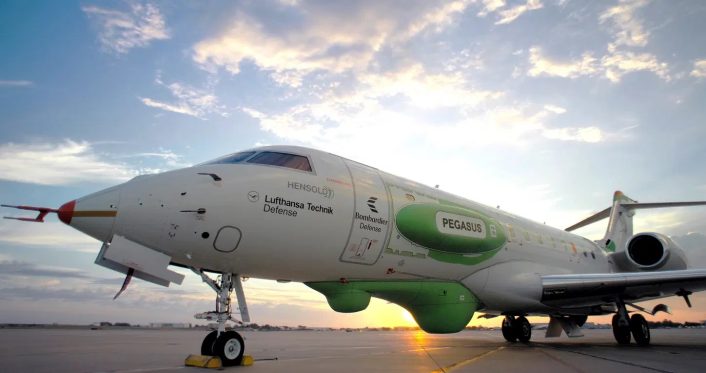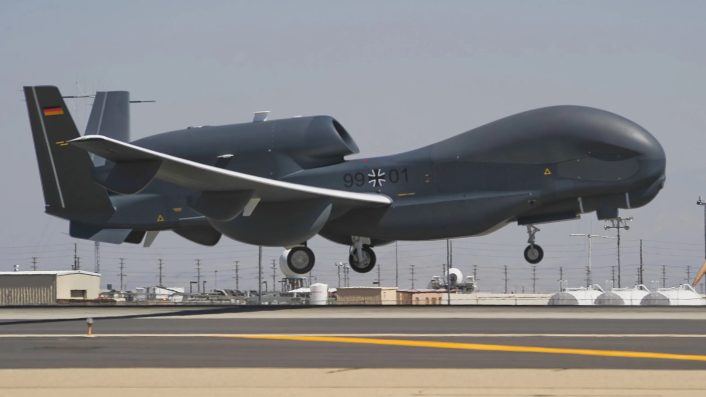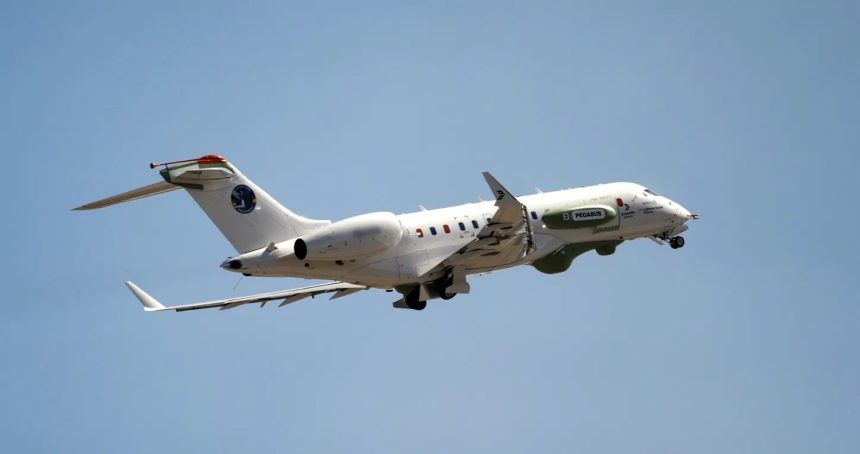The PEGASUS aircraft, based on the Bombardier Global 6000, is the first of three that will be later integrated with the Hensoldt Kalætron Integral SIGINT sensor suite for the German Air Force.
Lufthansa Technik Defense has announced the maiden flight of the first of three PEGASUS SIGINT aircraft currently being developed for the German Air Force. The Persistent German Airborne Surveillance System (PEGASUS) aircraft, based on the Bombardier Global 6000, flew on Oct. 23, 2024, from Bombardier’s facility in Wichita, Kansas.
Hensoldt, Lufthansa Technik Defense and Bombardier Defense are working together on this program, which is creating an airborne missionized platform that will integrate the Hensoldt Kalætron Integral SIGINT (Signal Intelligence) system to perform highly critical signal surveillance missions for the German armed forces. Lufthansa Technik Defense will lead the systems integration and certification phase which is planned after the test flights.
This stage of aircraft testing is conducted by the Bombardier Flight Test Centre (BFTC) team, located in Wichita, where Bombardier’s pilots will validate key aspects of the program, says the press release. The first flight represents a significant milestone for the first of three modified Global 6000 aircraft destined to be delivered to the German Bundeswehr.
“Germany’s next generation signal intelligence aircraft is flying high,” said Steve Patrick, Vice President, Bombardier Defense. “This successful first flight is the result of the strong collaboration and shared knowledge between HENSOLDT, Lufthansa Technik Defense, Bombardier Defense and our suppliers to get the modified, high-performing Global 6000 aircraft for the Pegasus program in the air. With flight testing regularly underway from Bombardier’s Wichita base, the aircraft continues to gather essential certification data to improve and perfect the platform before it moves to the next stage.”
The Bombardier Global 6000 has become a versatile and reliable platform for military operations around the world, as its high-speed, long-range, and spacious interior make it ideal for a variety of special missions, including Intelligence, Surveillance, and Reconnaissance (ISR), Electronic Warfare (EW), and Airborne Early Warning (AEW). The U.S. Air Force’s Battlefield Airborne Communications Node (BACN) program is one notable example of the military use of the Global 6000.

The PEGASUS program
The Persistent German Airborne Surveillance System (PEGASUS) is a significant initiative by the German Air Force to enhance its airborne surveillance capabilities, which aims to fill the gap left by the retirement of the Breguet BR1150 Atlantic aircraft in 2010. As mentioned, the new aircraft will be based on the Bombardier Global 6000.
In June 2021, Hensoldt was awarded a € 1 billion contract to supply an airborne system for electronic signals intelligence based on its Kalætron Integral system. Hensoldt, Lufthansa Technik Defense and Bombardier have collaborated closely on a joint design activity as extensive structural modification work had to be performed to prepare the first aircraft.
In fact, the aircraft can be seen now equipped with two fairings on each side of the fuselage, as well as a larger, two-pronged one below the fuselage. These will host the sensor suite which will be later integrated on the aircraft. “With the integration of our Kalætron-Integral system, we are delivering key components that are essential for the ‘reconnaissance of tomorrow’,” said Dietmar Thelen, Head of Spectrum Dominance Division at HENSOLDT.
Upon completion of initial testing, each aircraft will be transferred to Lufthansa Technik Defense’s facilities in Hamburg for further integration work. The company is also responsible for the regulatory certification of PEGASUS on the overall aircraft level. So far, according to the statement, Lufthansa Technik has completed its design activities for the integration of the mission system, the additional civil and military avionics systems as well as the aircraft cabin.
The production process of interior parts has also already started in order to ensure the components’ readiness for immediate installation when the aircraft arrives in Hamburg, says the company. In the meantime, Hensoldt has adapted the systems architecture to the operational needs of the German Bundeswehr.
Although only three aircraft have been ordered so far, Hensoldt expects the Luftwaffe to increase the size of the fleet. In fact, speaking to media, a company representative said the aircraft on order might not be enough to fulfil the tasking required by the general deterioration in the global geopolitical picture.
“The initial contract is for three aircraft, and we are proud to be in a position to deliver those. If you look at the current geopolitical situation, even though any aircraft can persistently monitor a vast area, there are unfortunately too many hot spots globally. So, we expect an additional rise [in aircraft numbers] to be coming eventually,” said Jürgen Halder, vice-president, Airborne SIGINT at Hensoldt.
Halder’s remarks derive from the RQ-4E Euro Hawk procurement’s numbers which, at the time of its cancellation in 2013, included a fleet of five aircraft. “Discussions are starting in a very early phase, but it’s apparent that three aircraft are not sufficient, especially if you consider that the Euro Hawk programme had already included much higher numbers of aircraft,” said the official.

Kalætron Integral
Kalætron Integral is an airborne SIGINT solution that provides a “comprehensive strategic asset for wide-area reconnaissance, mastering the challenges posed by today’s electromagnetic spectrum,” says Hensoldt. The system integrates intelligence gathered from both radar signals (ELINT) and communication signals (COMINT) in a single package which covers the entire electromagnetic spectrum with continuous frequency coverage from less than 30 MHz to 40 GHz.
Hensoldt also says on its website that Kalætron features highly automated workflows powered by machine learning and AI algorithms, which accelerate the decision-making while reducing the workload of operators. This allows to obtain a constantly evolving view of the electromagnetic order of battle, combining insights from various platforms in all domains into a single intelligence picture.
The combination of superior altitude and long range enables the system to cover vast areas at a safe distance from potential threats, says the producer, with a detection range of about 400 km. The website further states the system features “exceptional accuracy, high sensitivity, a broad frequency range and extended time on station,” without delving into details.









